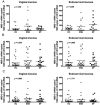Increased levels of human beta-defensins mRNA in sexually HIV-1 exposed but uninfected individuals
- PMID: 18991618
- PMCID: PMC4126611
- DOI: 10.2174/157016208786501463
Increased levels of human beta-defensins mRNA in sexually HIV-1 exposed but uninfected individuals
Abstract
Protection against HIV-1 infection in exposed seronegative (ESN) individuals likely involves natural resistance mechanisms that have not been fully elucidated. Human beta defensins (HBD) are antimicrobial peptides found primarily in mucosae, the main ports of HIV entry. HBD-2 and 3 mRNA are induced by HIV-1 in human oral epithelial cells and exhibit strong anti-HIV-1 activity; in addition, polymorphisms in the DEFB1 gene, which encodes HBD-1, have been associated with resistance/susceptibility to different infections, including HIV-1. Here, we have assessed the association of HBD expression with the ESN phenotype. Peripheral blood and vaginal/endocervical and oral mucosal samples were taken from 47 ESN, 44 seropositive (SP) and 39 healthy controls (HC). HBD-1, 2 and 3 mRNA copy numbers were quantified by real time RT-PCR and A692G/G1654A/A1836G polymorphisms in the DEFB1 gene were detected by restriction fragment length polymorphisms and confirmed by nucleotide sequencing. ESN expressed significantly greater mRNA copy numbers of HBD-2 and 3 in oral mucosa than HC; p=0.0002 and p=0.007, respectively. mRNA copy numbers of HBD-1, 2 and 3 in vaginal/endocervical mucosa from ESN and HC were similar. Homozygosity for the A692G polymorphism was significantly more frequent in ESN (0.39) than in SP (0.05) (p=0.0002). In summary, ESN exhibited enhanced mucosal expression of the innate defense genes HBD-2 and 3; however, additional studies are required to verify these results and the potential association of the A692G polymorphism to the relative resistance of ESN to HIV-1 infection.
Figures


References
-
- UNAIDS. Report on the global AIDS epidemic. Joint United Nations Programme on HIV/AIDS; Geneva: 2007. Available at: http://www.unaids.org/en/KnowledgeCentre/HIVData/EpiUpdate/EpiUpdArchive....
-
- Shearer GM, Clerici M. Protective immunity against HIV infection: has nature done the experiment for us? Immunol Today. 1996;17:21–4. - PubMed
-
- McMichael AJ, Rowland-Jones SL. Cellular immune responses to HIV. Nature. 2001;410:980–7. - PubMed
-
- Sierra S, Kupfer B, Kaiser R. Basics of the virology of HIV-1 and its replication. J Clin Virol. 2005;34:233–44. - PubMed
-
- Montoya CJ, Velilla PA, Chougnet C, Landay AL, Rugeles MT. Increased IFN-gamma production by NK and CD3+/CD56+ cells in sexually HIV-1-exposed but uninfected individuals. Clin Immunol. 2006;120(2):138–46. - PubMed

